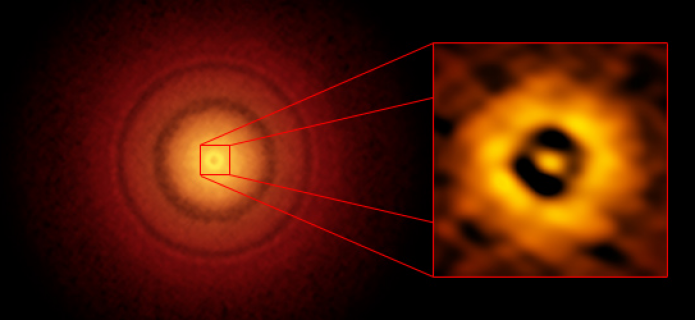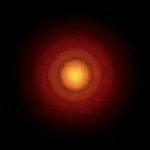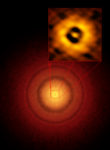ALMA's Best Image of a Protoplanetary Disk
The disks of dust and gas that surround young stars are the formation sites of planets. New images from the Atacama Large Millimeter/submillimeter Array (ALMA) reveal never-before-seen details in the planet-forming disk around a nearby Sun-like star, including a tantalizing gap at the same distance from the star as the Earth is from the Sun. This structure may mean that an infant version of our home planet, or possibly a more massive super-Earth, is beginning to form there.
The star, TW Hydrae, is a popular target of study for astronomers because of its proximity to Earth (approximately 175 light-years away) and its status as a veritable newborn (about 10 million years old). It also has a face-on orientation as seen from Earth. This affords astronomers a rare, undistorted view of the complete disk.
"Previous studies with optical and radio telescopes confirm that this star hosts a prominent disk with features that strongly suggest planets are beginning to coalesce," said Sean Andrews with the Harvard-Smithsonian Center for Astrophysics in Cambridge, Mass., and lead author on a paper published today in Astrophysical Journal Letters. "The new ALMA images show the disk in unprecedented detail, revealing a series of concentric dusty bright rings and dark gaps, intriguing features that suggest a planet with an Earth-like orbit is forming there."

ALMA image of the planet-forming disk around the young, Sun-like star TW Hydrae. The inset image (upper right) zooms in on the gap nearest to the star, which is at the same distance as the Earth is from the Sun, suggesting an infant version of our home planet could be emerging from the dust and gas. The additional concentric light and dark features represent other planet-forming regions farther out in the disk. Credit: S. Andrews (Harvard-Smithsonian CfA), ALMA (ESO/NAOJ/NRAO) | Download image
Other pronounced gap features are located 3 billion and 6 billion kilometers from the central stars, similar to the distances from the Sun to Uranus and Pluto in our own Solar System. They too are likely the result of particles that came together to form planets, which then swept their orbits clear of dust and gas and shepherded the remaining material into well-defined bands.

ALMA image of the disk around the young star TW Hydrae. ALMA obtained its best image of a protoplanetary disk to date, revealing the classic rings and gaps that signify planets are in formation in this system. Credit: S. Andrews (Harvard-Smithsonian CfA); B. Saxton (NRAO/AUI/NSF); ALMA (ESO/NAOJ/NRAO) | Download image
For the new TW Hydrae observations, astronomers imaged the faint radio emission from millimeter-size dust grains in the disk, revealing details on the order of the distance between the Earth and the Sun (about 150 million kilometers). These detailed observations were made possible with ALMA’s high-resolution, long-baseline configuration. When ALMA's dishes are at their maximum separation, up to 15 kilometers apart, the telescope is able to resolve finer details. "This is the highest spatial resolution image ever of a protoplanetary disk from ALMA, and that won't be easily beat going forward," said Andrews [1].

The inner region of the TW Hydrae protoplanetary disk as imaged by ALMA. The image has a resolution of 1 AU (Astronomical Unit, the distance from the Earth to the Sun in our own Solar System). This new ALMA image reveals a gap in the disk at 1 AU, suggesting that a planet with the same orbit as Earth is forming there. Credit. S. Andrews (Harvard-Smithsonian CfA); B. Saxton (NRAO/AUI/NSF); ALMA (ESO/NAOJ/NRAO) | Download image
"TW Hydrae is quite special. It is the nearest known protoplanetary disk to Earth and it may closely resemble our Solar System when it was only 10 million years old," said co-author David Wilner, also with the Harvard-Smithsonian Center for Astrophysics.
Earlier ALMA observations of another system, HL Tau, show that even younger protoplanetary disks – a mere 1 million years old – can display similar signatures of planet formation. By studying the older TW Hydrae disk, astronomers hope to better understand the evolution of our own planet and the prospects for similar systems throughout the Galaxy.
The astronomers' next phase of research is to investigate how common these kinds of features are in disks around other young stars and how they might change with time or environment.
Artist's animation of a protoplanetary disk. Newly formed planets can be seen traveling around the central host star, sweeping their orbits clear of dust and gas. These same ring-link structures were observed recently by ALMA around the young star HL Tau. Credit: National Science Foundation, A. Khan
Note
[1] The angular resolution of the images of HL Tauri was similar to these new observations, but as TW Hydrae is much closer to Earth, finer details can be seen.
Additional information
This research was presented in a paper "Ringed Substructure and a Gap at 1 AU in the Nearest Protoplanetary Disk", by S.M. Andrews et al., appearing in the Astrophysical Journal Letters.
The team is composed of Sean M. Andrews (Harvard-Smithsonian Center for Astrophysics, Cambridge, Massachusetts, USA), David J. Wilner (Harvard-Smithsonian Center for Astrophysics, Cambridge, Massachusetts, USA) , Zhaohuan Zhu (Princeton University, Princeton, New Jersey, USA), Tilman Birnstiel (Max-Planck-Institut für Astronomie, Heidelberg, Germany), John M. Carpenter (Joint ALMA Observatory, Santiago, Chile), Laura M. Pérez (Max-Planck-Institut für Radioastronomie, Bonn, Germany), Xue-Ning Bai (Harvard-Smithsonian Center for Astrophysics, Cambridge, Massachusetts, USA), Karin I. Öberg (Harvard-Smithsonian Center for Astrophysics, Cambridge, Massachusetts, USA), A. Meredith Hughes (Wesleyan University, Van Vleck Observatory, Middletown, USA), Andrea Isella (Rice University, Houston, Texas, USA) and Luca Ricci (Harvard-Smithsonian Center for Astrophysics, Cambridge, Massachusetts, USA).
The Atacama Large Millimeter/submillimeter Array (ALMA), an international astronomy facility, is a partnership of the European Organisation for Astronomical Research in the Southern Hemisphere (ESO), the U.S. National Science Foundation (NSF) and the National Institutes of Natural Sciences (NINS) of Japan in cooperation with the Republic of Chile. ALMA is funded by ESO on behalf of its Member States, by NSF in cooperation with the National Research Council of Canada (NRC) and the Ministry of Science and Technology (MOST) in Taiwan and by NINS in cooperation with the Academia Sinica (AS) in Taiwan and the Korea Astronomy and Space Science Institute (KASI).
ALMA construction and operations are led by ESO on behalf of its Member States; by the National Radio Astronomy Observatory (NRAO), managed by Associated Universities, Inc. (AUI), on behalf of North America; and by the National Astronomical Observatory of Japan (NAOJ) on behalf of East Asia. The Joint ALMA Observatory (JAO) provides the unified leadership and management of the construction, commissioning and operation of ALMA.
Link
Contacts
-
Valeria Foncea
Education and Public Outreach ManagerJoint ALMA Observatory Santiago - ChilePhone: +56 2 2467 6258Cel: +56 9 7587 1963Email: [email protected] -
Charles E. Blue
Public Information OfficerNational Radio Astronomy Observatory Charlottesville, Virginia - USAPhone: +1 434 296 0314Cel: +1 202 236 6324Email: [email protected] -
Masaaki Hiramatsu
Education and Public Outreach Officer, NAOJ Chile -
Richard Hook
Public Information Officer, ESOGarching bei München, GermanyPhone: +49 89 3200 6655Cel: +49 151 1537 3591Email: [email protected]



